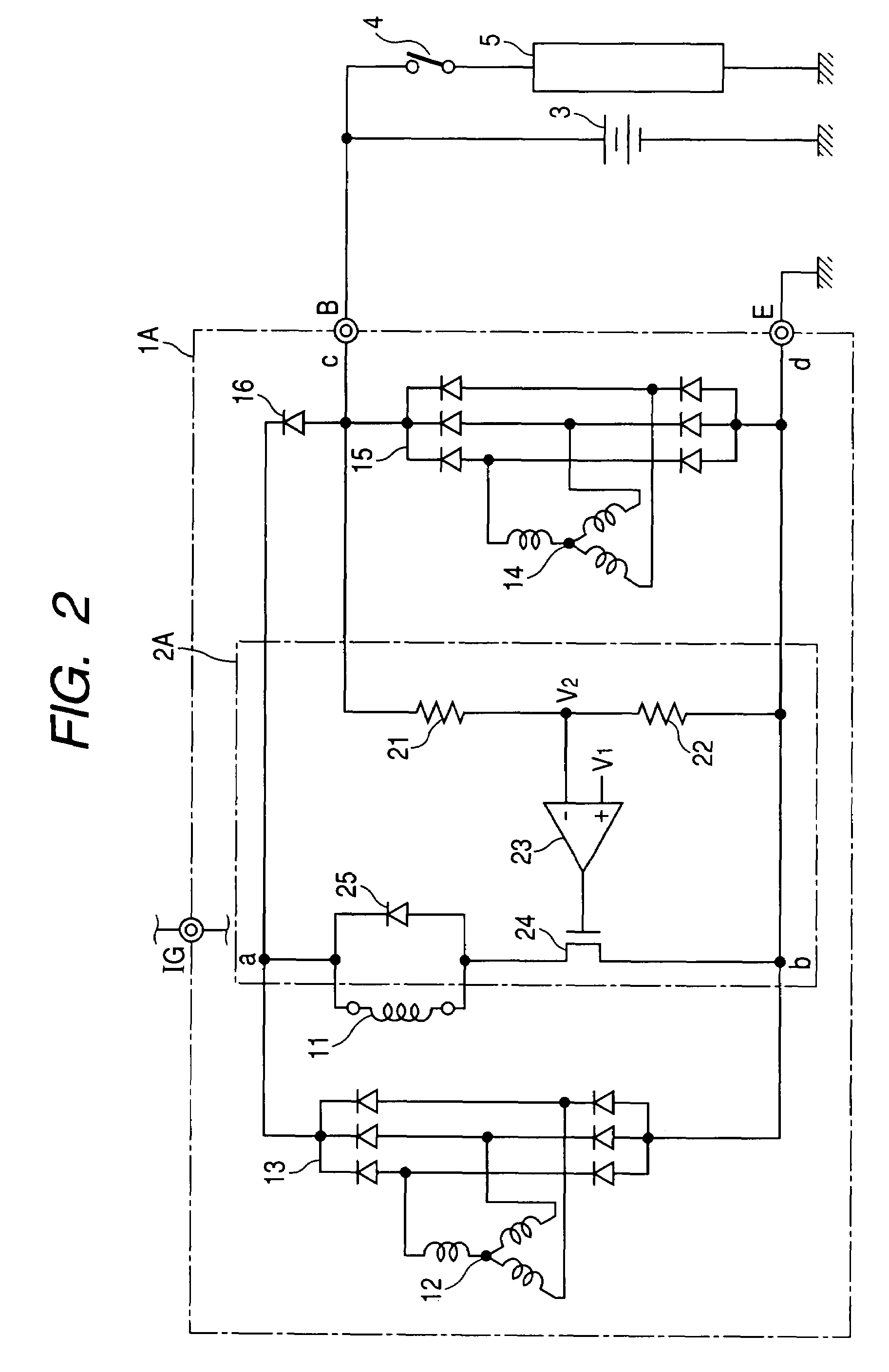Alternator
a technology of alternators and alternators, applied in the direction of electric generator control, dynamo-electric converter control, control systems, etc., can solve the problems of increasing the electrical power consumption of vehicles, increasing the tendency of increasing electrical power consumption, and unable to achieve sufficient electric power generation in vehicles at present, so as to achieve stable operation and suppress heat evolution in excitation wiring
- Summary
- Abstract
- Description
- Claims
- Application Information
AI Technical Summary
Benefits of technology
Problems solved by technology
Method used
Image
Examples
first embodiment
1. First Embodiment
[0029]With reference to FIG. 1, an alternator 1 according to a first embodiment of the present invention is described below in the order of its configuration, operation and advantages.
1.1 Configuration
[0030]FIG. 1 is a block diagram showing the configuration of the alternator 1 according to the first embodiment from an electrical circuit view. FIG. 1 also shows a state of electrical connections between the alternator, a battery, etc.
[0031]As shown in FIG. 1, the alternator 1 comprises an excitation winding 11, an excitation armature winding 12, an excitation rectifier 13 (hereinafter referred to as a “first rectifier 13”), an output armature winding 14, an output rectifier 15 (hereinafter referred to as a “second rectifier 15”), a rectifying element 16 and a power generation unit 2.
[0032]The excitation armature winding 12 is provided for exciting the excitation winding 11 so as to enable the alternator 1 to generate electric power, while the output armature windin...
second embodiment
2. Second Embodiment
[0058]Referring to FIG. 2, a second embodiment of the present invention will now be described.
[0059]FIG. 2 is a block diagram showing a configuration of an alternator according to a second embodiment of the present invention. FIG. 2 also shows a state of electrical connection between the alternator, a battery, etc. In the present embodiment, the identical or similar components or processes to those of the first embodiment are given the same references as in the first embodiment for the sake of simplification or omission of explanation.
[0060]As shown in FIG. 2, an alternator 1A of the present embodiment comprises the excitation winding 11, the excitation armature winding 12, the first rectifier (excitation rectifier) 13, the output armature winding 14, the second rectifier (output rectifier) 15, the rectifying element 16 and a power generation control unit 2A.
[0061]The alternator 1A of the present embodiment shown in FIG. 2 is different from the alternator 1 of th...
third embodiment
3. Third Embodiment
[0067]Referring to FIG. 3, a third embodiment of the present invention will now be described.
[0068]In the alternator 1 and the alternator 1A of the first and the second embodiments described above, respectively, the first rectifier 13 and the second rectifier 15 have been electrically separated by employing the rectifying element 16, and the initial excitation current has been supplied to the excitation winding 11 through this rectifying element 16 from the battery 3. However, such a rectifying element can be omitted in a circuit configuration in which electric power can be generated with the rotation of the rotor without having to supply the initial excitation current (e.g., a circuit configuration employing a rotor which uses both a permanent magnet and an electromagnet). An alternator 1B of a third embodiment exemplifies such a circuit configuration.
[0069]FIG. 3 is a block diagram showing a configuration of the alternator 1B of the third embodiment. FIG. 3 also...
PUM
 Login to View More
Login to View More Abstract
Description
Claims
Application Information
 Login to View More
Login to View More - R&D
- Intellectual Property
- Life Sciences
- Materials
- Tech Scout
- Unparalleled Data Quality
- Higher Quality Content
- 60% Fewer Hallucinations
Browse by: Latest US Patents, China's latest patents, Technical Efficacy Thesaurus, Application Domain, Technology Topic, Popular Technical Reports.
© 2025 PatSnap. All rights reserved.Legal|Privacy policy|Modern Slavery Act Transparency Statement|Sitemap|About US| Contact US: help@patsnap.com



